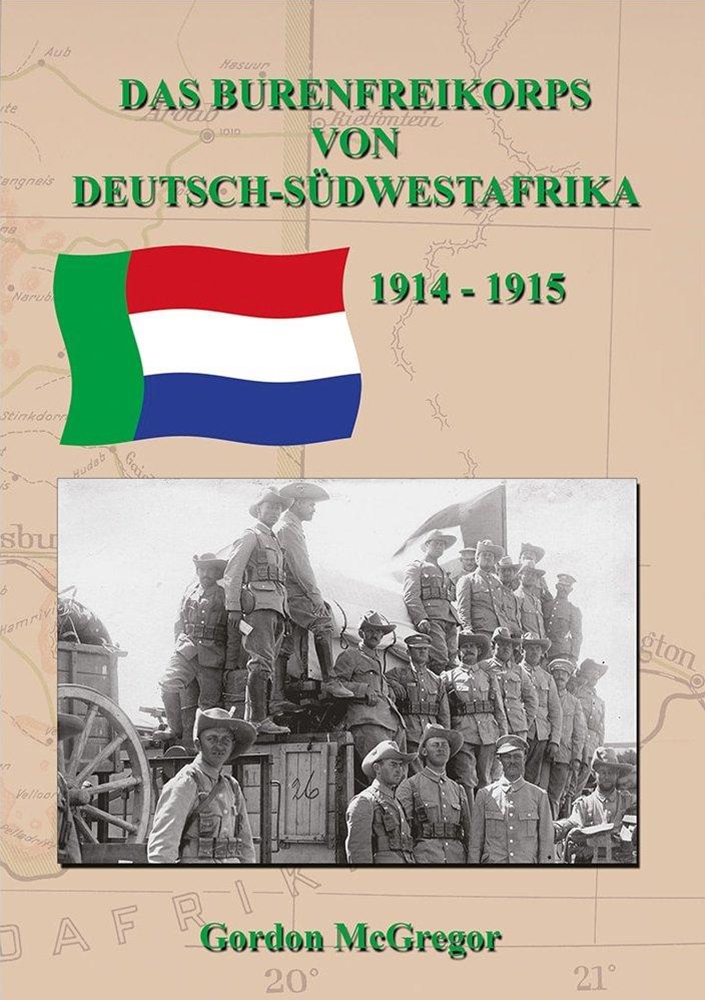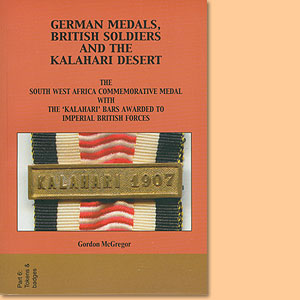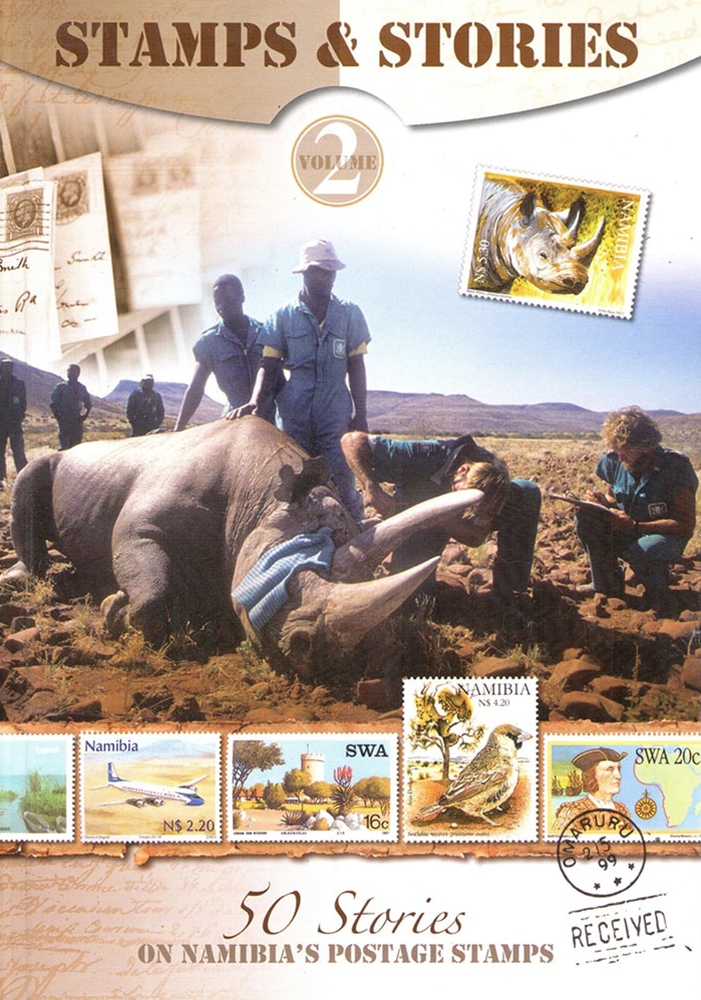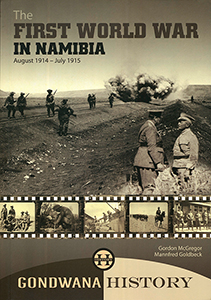Gondwana History: Memorable Moments from Namibia's Past, 3rd edition, by Gordon McGregor et al.

Gondwana History: Memorable Moments from Namibia's Past, 3rd edition, by Gordon McGregor et al. Nature Investments. Namibia, 2012. ISBN 99789994573226 / ISBN 978-99945-73-22-6
Gondwana History: Memorable Moments from Namibia's Past, 3rd edition, by Gordon McGregor et al. consits of stories from Namibia's past have been published in local newspapers the Republikein and Allgemeine Zeitung weekly since 2010. Their positive reception and success of the series shows just how compelling and intriguing Namibian history can be.
Gordon McGregor Sven-Eric Kanzler Mannfred Goldbeck Antje Otto
The Black Rock: Monument to a Fatal Misunderstanding (Walter Rusch)
The former oxwagon route from Windhoek to Seeis passes a rock with "Schwarze Klippe 14.2.04" (Black Rock) inscribed on it. On noticing this rock one cannot help but wonder what happened there. It is little known that at the beginning of the Herero uprising in 1904 German soldiers accidentally shot at their comrades in a skirmish close to this rock. On 14 February 1904, at six in the morning, 1st Company under Captain Fischel marches off from Windhoek to Gobabis. They have orders to take action against rebellious Hereros en route. Decommissioned Captain Hugo von Francois (the brother of Curt von Francois) rides ahead with a patrol. They encounter a group of Hereros that very morning. During a brief exchange of fire the Hereros suffer several losses while on the German side one mounted soldier has a finger shot off and his rifle is damaged. At midday 1 st Company arrives at Abraham's farm (today's Finkenstein). They find it totally destroyed but stop to rest during the heat of the early afternoon. Captain von Francois reports to Fischel and then rides back to Windhoek. At four in the afternoon the company is on its way again, expecting to reach the waterhole at the Black Rock after a march of about one-and-a-half hours. As it turns out, they misjudge time and distance and after covering a total of 40 km that day, the company finally reaches the waterhole at dusk. Several non-commissioned officers ride on ahead to find a suitable spot for their camp. Since darkness is already falling there is no time to reconnoitre for traces of the enemy. The vanguard coordinates the pitching of the camp, which is no easy task due to the company's large number of wagons and cattle. Among other things, there are wagons and carts with provisions, medical supplies, ammunition and oats. All of them are arranged in a square lager. The draught oxen are tied to the chains of their harness and the cattle are driven into the lager. The non-commissioned officers get together for roll call and decide on a password to be used when entering the camp at night. Guards are posted on every side of the camp. No fires are allowed that night. While the soldiers are still preparing their bivouac they hear several shots ring out from sentry position number 4. The Hildebrandt unit is immediately sent out with fixed bayonets. After barely 50 paces the unit is fired on from both sides, but since they do not know the surroundings they are ordered to retreat to the lager again. Sentry 3, who was also shot at, comes running back into the lager, shouting "don't shoot, this is sentry 3". Total confusion reigns when minutes later the suspected enemy also approaches the camp shouting: "Don't shoot, we are German soldiers!" They are asked for the password and their names. As no reply is forthcoming, 1st Company starts firing in the direction of the would-be attackers. The author of this story, Walter Rusch, on the Black Rock. Gradually the sound of rifle fire dies down on both sides of the camp. The soldiers spend the night at the firing line with their rifles at the ready. At dawn several grenades are thrown into the surrounding area, followed by an inspection of the night's "battlefield" by the Hildebrandt unit. They find four German marines, one of them still alive. Herman Haense is badly wounded and immediately taken back to Windhoek. Ernst Mahnke, Johann Schneider and Wilhelm Luttermoller (or F Suttermuller according to other sources) are buried at noon with military honours. A pile of rocks and a wooden cross mark their joint grave near the Black Rock. Even today the grave is clearly recognisable. The barbed-wire fencing, which was probably added later, is still there. Today the graves of the three marines who died at the Black Rock are marked by an enclosed pile of stones. Three graves on the eastern side of the war cemetery in Seeis are also in memory of the three marines, although it is unlikely that their mortal remains were transferred there. The results of an investigation into the Black Rock incident were probably never published due to the utter embarrassment over the mishap. Apparendy it was an ill-fated encounter of German soldiers who had not been informed about each other's presence in the area.
This is an excerpt from Gondwana History: Memorable Moments from Namibia's Past, 3rd edition, by Gordon McGregor et al.
Title: Gondwana History: Memorable Moments from Namibia's Past, 3rd edition
Authors: Walter Rusch; Mannfred Goldbeck; Inke Stoldt; Sven-Eric Kanzler; Antje Otto; Gordon McGregor; Ron Swilling; Errol Hurter
Series: Gondwana History, Vol 3
Publisher: Nature Investments
Namibia, 2012
ISBN 99789994573226 / ISBN 978-99945-73-22-6
Softcover, 15 x 21 cm, 111 pages, 85 images, 1 map, English text
Rusch, Walter und Goldbeck, Mannfred und Stoldt, Inke und Kanzler, Sven-Eric und Otto, Antje und McGregor, Gordon und Swilling, Ron und Hurter, Errol im Namibiana-Buchangebot
Gondwana History: Memorable Moments from Namibia's Past, 3rd edition
Gondwana History: Memorable Moments from Namibia's Past, 3rd edition, is a collection of 30 tales of Namibian history, culture and nature.
Road Tripping Namibia (Mapstudio)
Road Tripping Namibia showcases a selection of 15 iconic road trips, all perfectly manageable in a normal car.
The History of Freemasony in Namibia 1905-2019
The History of Freemasony and of the various Lodges and Chapters in Namibia 1905-2019.
South West African Wheel Tax Badges 1926-1961
The wheel tax metal badge came into existence as a result of Ordinance No. 6 of 1926 of the South West Africa Administration. The last badge was issued in 1961.
The Merit Medal for Combatants in German South West Africa 1892-1918
The Merit Medal for Combatants in German South West Africa 1892-1918 was awarded to members of the native population.
Orden- und Medaillenverleihung für den Feldzug in Deutsch-Südwestafrika 1914-1915
Endlich eine vollständige Namesliste für die Orden- und Medaillenverleihung für den Feldzug in Deutsch-Südwestafrika 1914-1915!
The Equestrian Monument (Reiterdenkmal) 1912-2014
A chronological documentation of reports, newspaper clippings and photos/illustrations related to the Equestrian Monument (Reiterdenkmal) 1912-2014.
Seekrieg in Angra Pequena
Dieses hochinteressante Buch erzählt die wahre Geschichte über den sogenannten Seekrieg in Angra Pequeña (Lüderitzbucht) und was sich 1863 dort tatsächlich zugetragen hat.
Das Reiterdenkmal 1912-2014
Diese chronologische Dokumentation zeigt anhand von Berichten, Artikeln und Fotos die Ereignisse um das Reiterdenkmal in Windhoek, Namibia, im Zeitraum von 1912 bis 2014.
Die Eingeborenen-Passmarken von Deutsch-Südwestafrika
Dieses Standardwerk bietet einen Überblick über die Eingeborenen-Passmarken, die in der Kolonie Deutsch-Südwestafrika verwendet wurden.
Murder at Angra Pequeña
Murder at Angra Pequeña is the true story of an incident that happened in 1863 in South West Africa.
Das Burenfreikorps von Deutsch-Südwestafrika 1914-1915
Das Burenfreikorps von Deutsch-Südwestafrika 1914-1915: Aktivitäten von der Aufstellung des Burenfreikorps bis zu dessen Auflösung.
German Medals, British Soldiers and the Kalahari Desert
The South West Africa Commemorative Medal with the "Kalahari" Bars awarded to The Imperial British Forces
For Valour. The history of the Iron Cross and Wound Badge in German Southwest Africa 1914-1918
For Valour. The history of the Iron Cross and Wound Badge in German Southwest Africa 1914-1918.
The Prisoner of War Tokens of German South West Africa
The Prisoner of War Tokens of German South West Africa: A description and a historical view.
Die Kriegsgefangenenmarken von Deutsch-Südwestafrika
Eine sehr interessante Beschreibung der Kriegsgefangenenmarken von Deutsch-Südwestafrika mit geschichtlichem Abriß.
Journal 59-2011 (Namibia Wissenschaftliche Gesellschaft)
Dies ist die 59. Ausgabe des Journals der Namibia Wissenschaftlichen Gesellschaft von 2011.
Journal 63-2015 (Namibia Scientific Society)
A scientific series published by the Namibia Scientific Society, this is the Journal Nr. 63 from 2015.
Mythos Haar. Ethnographische Photografien aus alten Sammlungen Südwestafrikas
Die Photografien aus dem Band Mythos Haar sind als ethnographische Sammlungen Zeugen verschwindender Kulturen Südwestafrikas.
From Landesmuseum to National Museum of Namibia
100 Years (1907-2007) A chronology of an African Museum
Expelled from a beloved Country
Expelled from a beloved Country is the life story of German Settlers in Southern Namibia between Colonial War and World War I.
Vertrieben von geliebter Erde
Vertrieben von geliebter Erde ist Geschichte zweier Brüder aus Deutschland und der Farm Kairos in Südwestafrika.
Stamps & Stories: 50 Geschichten zu Briefmarken-Motiven Namibias, Band 2
Band 2 der Reihe Stamps & Stories erzählt 50 Geschichten zu den Hintergründen der Briefmarken-Motive Namibias.
Stamps & Stories: 50 Geschichten zu Briefmarken-Motiven Namibias
Die Reihe Stamps and Stories erzählt 50 Geschichten zu den Hintergründen der Entstehung der Briefmarken-Motive Namibias.
Stamps & Stories: 50 Stories of Namibia's Postage Stamps Vol 2
Stamps & Stories: 50 Stories of Namibia's Postage Stamps Vol 2 contains entertaining stories related to the images on Namibian postage stamps.
Stamps & Stories: 50 Stories of Namibia's Postage Stamps Vol 1
Stamps & Stories: 50 Stories of Namibia's Postage Stamps Vol 1 introduces to the postal history of Namibia.
Die Kulturgruppen in Namibias östlicher Sambesi-Region (Ost-Caprivi)
Die Kulturgruppen in Namibias östlicher Sambesi-Region (Ost-Caprivi): Eine historische Perspektive und ein Kapitel über Baobabs.
The First World War in Namibia August 1914 - July 1915
This book commemorates the 100th Anniversary of the beginning of the First World War in Namibia August 1914 - July 1915.
David Levin of Twyfelfontein
David Levin of Twyfelfontein is a nice book on Namibian local history and a farmer's biography.
The People of Namibia's Eastern Zambezi Region (Eastern Caprivi)
This series introduces to history, tribes and culture of the people of Namibia's Eastern Zambezi Region, the former Eastern Caprivi.
Keine Chance: Der Erste Weltkrieg in Namibia August 1914 - Juli 1915
Der Haupttitel 'Keine Chance' steht für die Lage der Schutztruppe in Namibia während des Ersten Weltkrieges von August 1914 bis Juli 1915.
David Levin auf Twyfelfontein
David Levin (1911-1983) war der erste und letzte weiße Farmer auf Twyfelfontein. Dies ist ein interessantes ortsgeschichtliches und biographisches Buch.
Wilde Pferde in der Namibwüste
Wilde Pferde in der Namibwüste ist eine Pferde-Biographie, die bei den frühen Equus-Gruppen ansetzt und ihre Verbreitung südlich der Sahara und insbesondere nach Namibia untersucht.
Wild horses in the Namib Desert
This is a comprehensive book on the wild horses living in the Namib Desert in south-western Namibia.
The first 100 years of State Railways in Namibia
This comprehensive and rare book surveys Namibia's railway history over the past 100 years before 1997.
Gondwana History: Memorable Moments from Namibia's Past, 5th edition
Gondwana History: Memorable Moments from Namibia's Past, 5th edition, is a collection of 30 tales of Namibian history, culture and nature.
Gondwana History: Memorable Moments from Namibia's Past, 4th edition
Gondwana History: Memorable Moments from Namibia's Past, 4th edition, is a collection of 30 tales of Namibian history, culture and nature.
Gondwana History: Memorable Moments from Namibia's Past, 2nd edition
This is the 2nd edition of Gondwana History with thirty memorable moments from Namibia's past times.
Gondwana History: Memorable Moments from Namibia's Past, 1st edition
This is the 1st edition/volume of the history series Gondwana History: Memorable Moments from Namibia's Past.
Journal 61-2013 (Namibia Wissenschaftliche Gesellschaft / Namibia Scientific Society)
Dies ist Band 61 des Journals der Namibia Wissenschaftliche Gesellschaft (Namibia Scientific Society), der 2013 herausgegeben wurde. Die Hauptbeiträge dieser Ausgabe sind in deutscher Sprache gehalten.
Gondwana History. Momentaufnahmen aus der Vergangenheit Namibias, Band 5
Namibia bietet zahllose spannende Episoden, die in der Reihe Gondwana History: Momentaufnahmen aus der Vergangenheit Namibias, nach und nach veröffentlicht werden.
Gondwana History. Momentaufnahmen aus der Vergangenheit Namibias, Band 4
Auch der vierte Band der Reihe Gondwana History fesselt mit zahlreichen kurzen Berichten und Momentaufnahmen aus der Vergangenheit Namibias.
Gondwana History. Momentaufnahmen aus der Vergangenheit Namibias, Band 2
Band 2 aus der Reihe Gondwana History bietet 25 Geschichte als Momentaufnahmen aus der Vergangenheit Namibias.
Gondwana History. Momentaufnahmen aus der Vergangenheit Namibias, Band 1
Die Buchreihe Gondwana History ist eine kurzweilige Sammlung interessanter Momentaufnahmen aus der Vergangenheit Namibias.
Afrikanischer Heimatkalender 1981
Dies ist der 51. Jahrgang Afrikanischer Heimatkalender für das Jahr 1981.
Lüderitzbucht. Damals und gestern
Damals und gestern steht für viele hochinteressante Beiträge, Fotos und Dokumente aus der jüngeren und alten Geschichte der Stadt Lüderitzbucht.
Gondwana History: Memorable Moments from Namibia's Past, 6th edition
Gondwana History: Memorable Moments from Namibia's Past, 6th edition, is a collection of 30 tales of Namibian history, culture and nature.
Gondwana History. Momentaufnahmen aus der Vergangenheit Namibias, Band 3
Dies ist der Band 3 aus der Reihe Gondwana History mit weiteren Momentaufnahmen aus der Vergangenheit Namibias.
















































